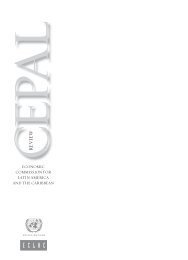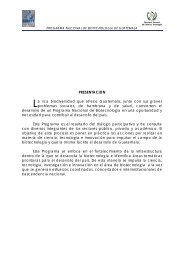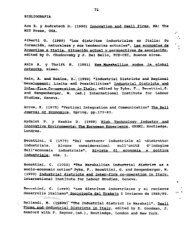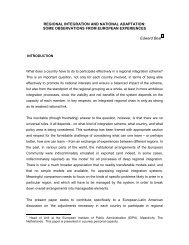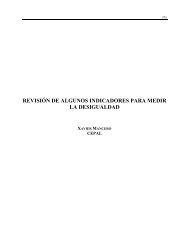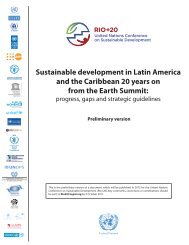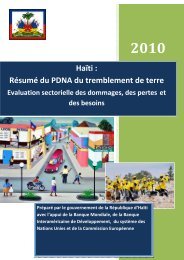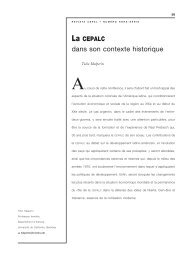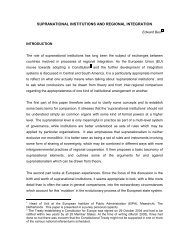Silvia Luna-Santos La recomposición familiar en México - Cepal
Silvia Luna-Santos La recomposición familiar en México - Cepal
Silvia Luna-Santos La recomposición familiar en México - Cepal
You also want an ePaper? Increase the reach of your titles
YUMPU automatically turns print PDFs into web optimized ePapers that Google loves.
<strong>La</strong> <strong>recomposición</strong> <strong>familiar</strong> <strong>en</strong> <strong>México</strong><br />
Abstract<br />
Changes in family structure in Mexico<br />
In Mexico, the predominant form of family structure consists of par<strong>en</strong>ts and childr<strong>en</strong> living together.<br />
Nevertheless, a large section of the population is experi<strong>en</strong>cing changes in family structure owing to the<br />
separation and successive unions of their par<strong>en</strong>ts. After separation, the childr<strong>en</strong> experi<strong>en</strong>ce having two<br />
par<strong>en</strong>ts in two households, the home of the par<strong>en</strong>t who has custody and the home of the other par<strong>en</strong>t.<br />
As the filial relationship is perman<strong>en</strong>t, the family is considered from the perspective of the childr<strong>en</strong>.<br />
This is the first Mexican study to draw att<strong>en</strong>tion to the population that is experi<strong>en</strong>cing changes in<br />
family structure. For this purpose an analysis is made of the conjugal and reproductive histories of<br />
wom<strong>en</strong> with childr<strong>en</strong> whose first union, at least, has be<strong>en</strong> dissolved. The filiation of the childr<strong>en</strong> of<br />
both members of the couple are also considered, in order to estimate the scale of changes in family<br />
structure in Mexico in 2003 and compare it with the corresponding estimate for 1997. The analysis<br />
also takes into account the addition of new members to the family, including step-mothers, step-fathers,<br />
step-brothers and step-sisters.<br />
Résumé<br />
<strong>La</strong> recomposition familiale au Mexique<br />
Le modèle prédominant de composition familiale au Mexique est la famille constituée par des par<strong>en</strong>ts<br />
et <strong>en</strong>fants corésid<strong>en</strong>ts. Un groupe important de population participe toutefois aux processus de<br />
recomposition familiale <strong>en</strong> raison de la séparation et des unions successives des par<strong>en</strong>ts. Après une telle<br />
séparation, les <strong>en</strong>fants connaiss<strong>en</strong>t une situation de “bipar<strong>en</strong>talité” dans deux foyers, celui du par<strong>en</strong>t<br />
qui <strong>en</strong> a la charge et celui qui ne réside pas avec eux. Étant donné le caractère pér<strong>en</strong>ne du li<strong>en</strong> par<strong>en</strong>t<strong>en</strong>fant,<br />
la famille est interprétée du point de vue des <strong>en</strong>fants. Cette étude cherche à faire apparaître, pour<br />
la première fois au Mexique, l’exist<strong>en</strong>ce de la population qui participe aux processus de recomposition<br />
familiale. Elle se base, pour ce faire, sur une analyse des trajectoires conjugales et de procréation des<br />
femmes ayant eu des <strong>en</strong>fants et dont au moins la première union a été dissolue. <strong>La</strong> différ<strong>en</strong>ciation<br />
de la filiation des <strong>en</strong>fants des deux membres du couple permet <strong>en</strong> outre d’évaluer l’ampleur de la<br />
recomposition familiale au Mexique <strong>en</strong> 2003 et de la comparer aux estimations correspondant à 1997.<br />
L’étude considère égalem<strong>en</strong>t la somme des nouveaux acteurs du contexte familial, à savoir notamm<strong>en</strong>t<br />
la belle-mère, le beau-père et les demi-frères et soeurs.



